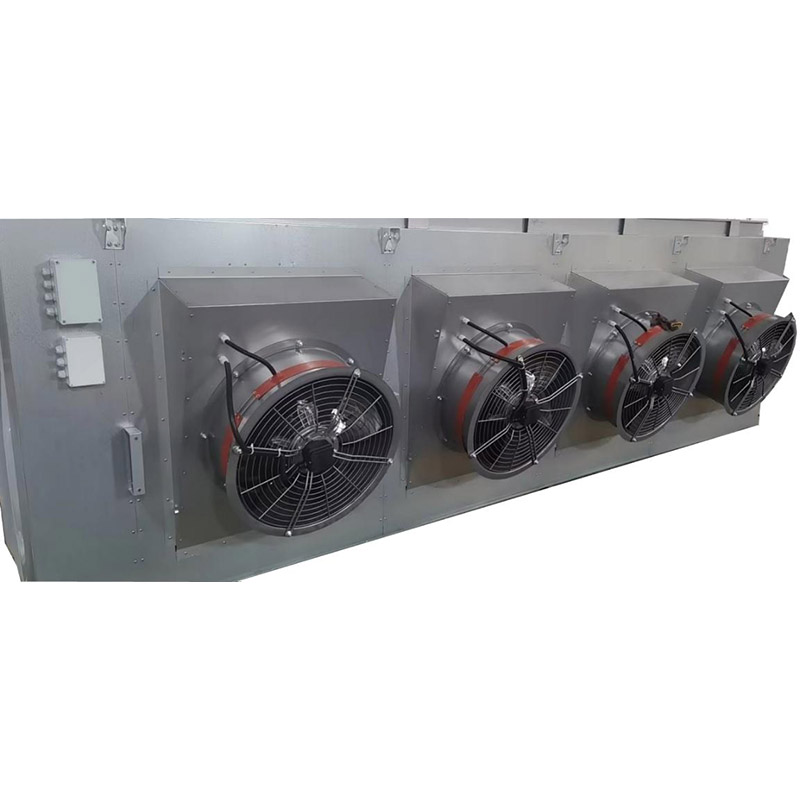One of the major components in any refrigeration system is the evaporator, which is a heat exchanger that allows refrigerant to absorb heat energy from the product to be cooled. As the refrigerant absorbs this heat energy, the refrigerant’s liquid component changes from a saturated liquid to a saturated vapor. When all of its liquid component has changed to a saturated vapor, the further addition of heat energy will cause the refrigerant’s vapor temperature to increase.
There are several types of direct expansion (DX) evaporators used in refrigeration equipment today. Semi-Hermetic Compressor

Gravity-type evaporators are normally constructed as one long length of copper tubing that is serpentined across a large area. The tubing can be bare or have aluminum fins attached. The aluminum fins increase the surface area of the evaporator, allowing for a shorter length of copper tubing to be used. They are usually installed across the entire top of a refrigerated case. As the air on top of the case is cooled, it will drop down and circulate across the product. At the same time, the warm air at the lower portion of the case will rise up to the evaporator. This will create a low-velocity airstream across the evaporator and create higher humidity within the case. This can be a great advantage for certain products, which tend to dry out more quickly when stored in cases with other types of evaporators.
Cold plate evaporators can be formed in one of two ways:
However, the most popular type of evaporator used today is the blower-style (unit cooler) evaporator. They are normally constructed using aluminum finned copper tubing with a fan assembly forcing air across its surface. Smaller unit coolers will typically be a single-circuited evaporator, while larger unit coolers will be multi-circuited evaporators.
In a blower-style evaporator, there is more than one circuit for the refrigerant to flow through. The refrigerant is fed into the top, middle, and bottom sections of the evaporator, allowing for a reduction in the pressure drop across the entire evaporator. The spacing between the fins is an important part of the design of this evaporator, because the smaller the fin spacing, the more heat energy can be transferred to the refrigerant. However, if the fin spacing is too small, frost or ice can accumulate quickly on the surface of the evaporator, requiring it to be defrosted more regularly.
The movement of air across the evaporator can either be forced draft or induced draft. Forced-draft evaporators have a motor and fan that are located on the inlet side and push the air through the evaporator. Induced-draft evaporators have a motor and fan located on the outlet size and pull the air through the surface of the evaporator. Induced-draft evaporators are typically used on walk-in coolers/freezers, and forced-draft evaporators are used on reach-on cooler/freezers. Recognizing this distinction can be helpful when deciding where to place the temperature control’s sensor. Most refrigerated cases will place its temperature control sensor on the air inlet side of the evaporator, except for open display cases that typically control based on an air curtain’s temperature.
Joe Marchese is an author, instructor and HVACR service contractor. He can be reached at joe@koldcraft.com.
You must have JavaScript enabled to enjoy a limited number of articles over the next 30 days.
Sponsored Content is a special paid section where industry companies provide high quality, objective, non-commercial content around topics of interest to The News audience. All Sponsored Content is supplied by the advertising company and any opinions expressed in this article are those of the author and not necessarily reflect the views of The News or its parent company, BNP Media. Interested in participating in our Sponsored Content section? Contact your local rep!
On Demand Don’t miss your chance to learn from industry thought leaders and gain valuable insight on how the A2L transition will affect your HVAC business!
Copyright ©2024. All Rights Reserved BNP Media.

Condenser Cooling Coil Design, CMS, Hosting & Web Development :: ePublishing